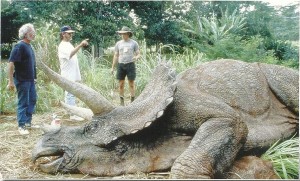 Stan Winston Studios created a full sized animatronic Triceratops for the first Jurassic Park film. The animatronic was used in the scene in which a Triceratops is ill and paleobotanist, Dr. Ellie Sattler, helps Jurassic Park veterinarian Dr. Gerry Harding determine what is causing the illness. The animatronic was also the only one filmed on location in Kauai and not on a sound stage in Los Angeles.
Stan Winston Studios created a full sized animatronic Triceratops for the first Jurassic Park film. The animatronic was used in the scene in which a Triceratops is ill and paleobotanist, Dr. Ellie Sattler, helps Jurassic Park veterinarian Dr. Gerry Harding determine what is causing the illness. The animatronic was also the only one filmed on location in Kauai and not on a sound stage in Los Angeles.
Design
The Triceratops was originally designed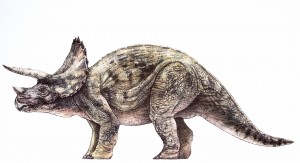 by Stan Winston Studio artist, Mark “Crash” McCreery. A small-scale maquette, based on McCreery’s design, was modified to be in a sick position on its side. The maquette was used to determine how the full-sized animatronic would move and where cables and pulleys would be placed.
by Stan Winston Studio artist, Mark “Crash” McCreery. A small-scale maquette, based on McCreery’s design, was modified to be in a sick position on its side. The maquette was used to determine how the full-sized animatronic would move and where cables and pulleys would be placed.
Full-Sized Animatronic Triceratops
Al Sousa was the lead mechanical designer for the sick Triceratops. For realism, the Triceratops was sculpted lying down. The animatronic had no hydraulics but instead, consisted mainly of cables and pulleys. A post in the chest cavity was activated by a lever and moved up and down to create a realistic breathing motion. A direct linkage mechanism 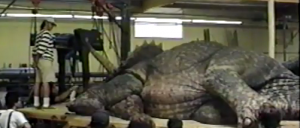 in the tail provided side to side and up and down movement. Joey Orosco was the Lead Triceratops Artist and, along with another Stan Winston Studios artist, Mark Jurinko, painted the detailed and elaborate pattern on the animatronic.
in the tail provided side to side and up and down movement. Joey Orosco was the Lead Triceratops Artist and, along with another Stan Winston Studios artist, Mark Jurinko, painted the detailed and elaborate pattern on the animatronic.
The studio was rushed to get the Triceratops to Kauai so the legs were removed to fit the animatronic in a shipping container. After arriving in Kauai a month later, the legs were reattached and Orosco finished the paint job. In Kauai, a pit was dug to house the control mechanisms and a platform, along with the animatronic, was placed over the pit. The 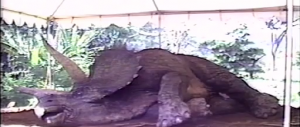 operators would descend into the pit where they would control the animatronic. One operator controlled the tail while another one controlled the legs and breathing mechanism. Above ground, operator Shannon Shea used a remote control to operate the eye movements. Shea was also responsible for the cosmetics of the animal. This included puss, saliva, and rheumy eyes. In order to create realistic microvesicles on the tongue, Shea used a syringe to fill a cavity with a mixture resembling puss. Onscreen actor, Laura Dern, would squeeze the microvesicle causing the “puss” to leak out.
operators would descend into the pit where they would control the animatronic. One operator controlled the tail while another one controlled the legs and breathing mechanism. Above ground, operator Shannon Shea used a remote control to operate the eye movements. Shea was also responsible for the cosmetics of the animal. This included puss, saliva, and rheumy eyes. In order to create realistic microvesicles on the tongue, Shea used a syringe to fill a cavity with a mixture resembling puss. Onscreen actor, Laura Dern, would squeeze the microvesicle causing the “puss” to leak out.
No walkie-talkies had arrived on location so Stan Winston directed the operators in the pit via a monitor. He coordinated the mouth and tongue movements to the rise and fall of the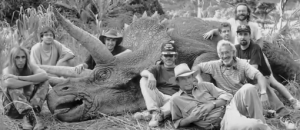 chest to make the animal look ill. He also wanted the leg movements to be slow as if the the animal had been sedated and was disoriented. For added realism, Mr. Winston had the crew get handfuls of dirt and cover the animatronic to mimic the behavior of modern animals such as rhinos and elephants.
chest to make the animal look ill. He also wanted the leg movements to be slow as if the the animal had been sedated and was disoriented. For added realism, Mr. Winston had the crew get handfuls of dirt and cover the animatronic to mimic the behavior of modern animals such as rhinos and elephants.
Works Cited- JURASSIC PARK TRICERATOPS-Part 1 and 2-Puppeteering an Animatronic Dinosaur. Stan Winston School of Character Arts (2013)

